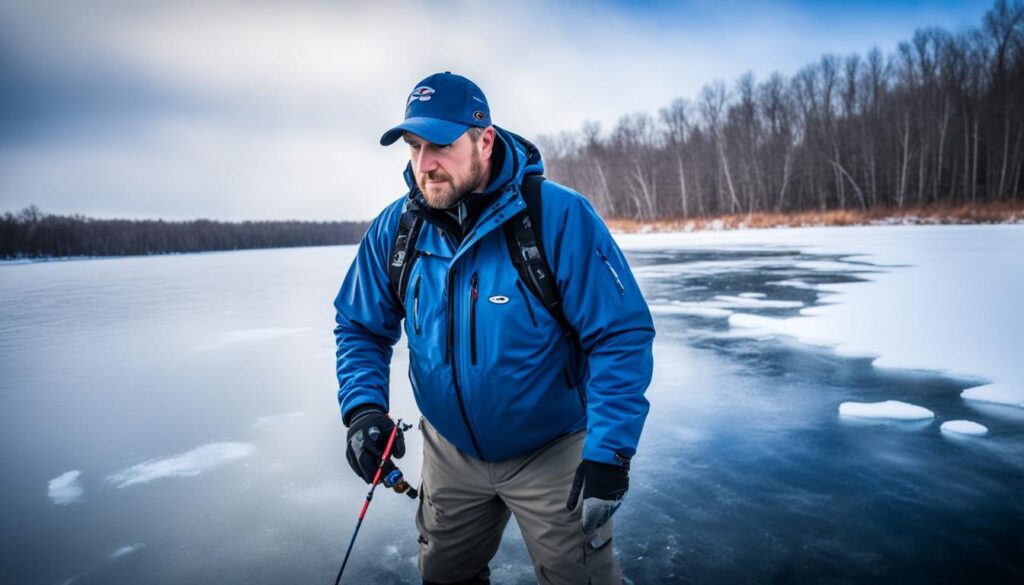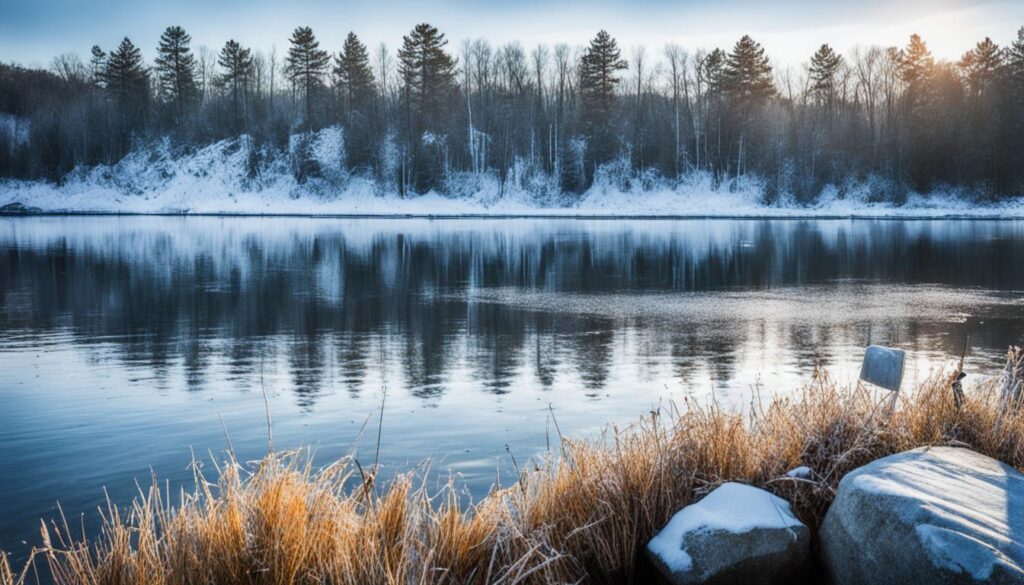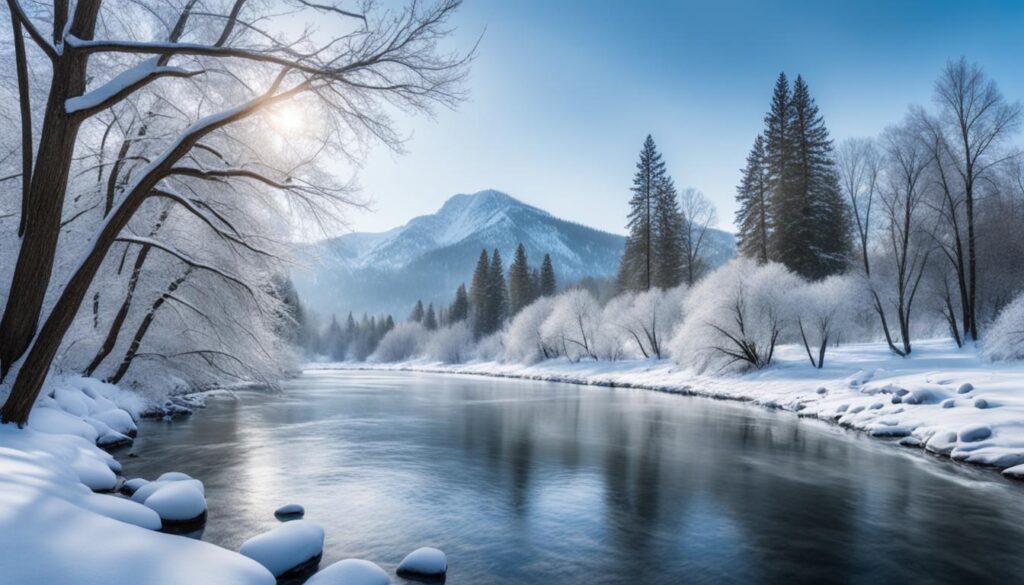Winter is the perfect time for bass fishing enthusiasts to brave the bitter cold and reel in big catches. Despite the challenging conditions, the colder water temperatures activate the fish, making it an ideal season for successful reservoir bass fishing. In this guide, we will reveal where bass hideout in winter reservoirs and provide valuable tips to ensure your winter bass fishing trips are productive and rewarding.
Key Takeaways:
- Winter is a great time to catch big bass due to the activation caused by cold fronts and intense weather.
- Understanding bass behavior in colder water is essential for adapting fishing techniques for success.
- Investing in high-quality gear and choosing the right lures and retrieves are crucial for winter bass fishing.
- Targeting submerged structures and deep drop-offs in reservoirs increases the chances of finding concentrated populations of bass.
- Always prioritize safety by wearing a life jacket, dressing in layers, and carrying emergency supplies.
The Importance of Cold Weather Fishing
Winter bass fishing requires a different approach due to the lower water temperatures. As cold-blooded creatures, bass become less active and their feeding frequency decreases. Understanding how bass behave in the winter will help anglers adapt their techniques for a successful catch. Slowing down retrieves, downsizing baits, and targeting areas with submerged structures are essential strategies for winter bass fishing.
Slowing Down Retrieves
During the winter, bass are less likely to chase down fast-moving prey. To increase your chances of a bite, it’s important to slow down the retrieve. By using a more deliberate and methodical approach, you can mimic the slow movements of natural prey and entice sluggish bass to strike. This technique is particularly effective in reservoirs where bass tend to be less active in cold water.
Downsizing Baits
In colder water, bass are more selective about their food sources. As a result, downsizing your baits can be highly effective in triggering strikes. By using smaller finesse lures such as small jigs, soft plastics, and jerkbaits, you can closely imitate the bass’s preferred winter forage, which often consists of small baitfish and insects. Matching the size of your bait to the natural prey in the water will increase your chances of enticing bites from less aggressive bass.
Targeting Areas with Submerged Structures
In winter, bass seek cover and protection from the cold. Submerged structures such as fallen trees, rock piles, and deep drop-offs provide ideal hiding spots for bass. By targeting these areas, you can increase your chances of finding a concentrated population of bass. These structures not only provide shelter but also serve as ambush points where bass can easily prey on unsuspecting baitfish. By focusing your efforts on submerged structures, you can maximize your success in winter bass fishing.
Summary
When it comes to winter bass fishing, understanding the importance of cold weather fishing techniques is key. Slowing down retrieves, downsizing baits, and targeting areas with submerged structures are proven strategies for finding bass in cold water. By adapting your approach to the lower water temperatures, you can increase your chances of a successful catch even in the harshest winter conditions.
Tackle and Gear for Winter Bass Fishing
A successful winter bass fishing outing requires the right tackle and gear. Investing in high-quality spinning or baitcasting reels is essential for durability and smooth casting. Additionally, having a selection of finesse lures is crucial for enticing sluggish bass in the cold water. Popular finesse lures for winter bass fishing include jigs, soft plastics, and jerkbaits.
When selecting lures, consider the specific conditions of the reservoir and the behavior of the bass. Jigs provide a lifelike presentation, imitating prey that bass are likely to feed on during the winter. Soft plastics offer versatility and can be worked slowly to entice bites from lethargic bass. Jerkbaits, on the other hand, mimic injured baitfish, triggering a reaction from nearby bass.
Choosing the right line and leader material is also crucial for winter bass fishing. Cold water conditions require lines with low visibility and high strength. Fluorocarbon and braided lines are popular choices, providing excellent sensitivity and strength.
Researching and identifying the best winter bass fishing spots in reservoirs can significantly increase your chances of success. Understanding the underwater topography, water temperature, and bass behavior will help you pinpoint the most productive areas to target. Pay attention to key features such as drop-offs, submerged structures, and areas with cover, as they often attract and hold bass during winter.
To summarize, here are the key tackle and gear considerations for winter bass fishing:
- Invest in high-quality spinning or baitcasting reels
- Build a collection of finesse lures such as jigs, soft plastics, and jerkbaits
- Select appropriate line and leader material, such as fluorocarbon or braided lines
- Research and identify the best winter bass fishing spots in reservoirs
| Tackle and Gear | Description |
|---|---|
| Spinning or baitcasting reels | High-quality reels for durability and smooth casting |
| Finesse lures | Jigs, soft plastics, and jerkbaits for enticing bites |
| Line and leader material | Low-visibility and high-strength options like fluorocarbon or braided lines |
| Research | Identify the best winter bass fishing spots in reservoirs |

Slow and Steady Retrieves
In winter, when the water is cold and bass are less active, it’s important to adjust your fishing techniques for a successful catch. Instead of using fast, aggressive retrieves, opt for slow and steady retrieves to entice sluggish bass. Mimicking the slow movements of natural prey can increase your chances of a bite. Here are a few finesse techniques that work particularly well in reservoirs during the winter season:
- Dragging: Drag your lure along the bottom, imitating the movement of a crawfish or other bottom-dwelling prey. Use a slow and steady drag, pausing occasionally to entice a strike.
- Hopping: Hop your lure along the bottom, imitating the movement of a wounded baitfish. Give your lure short, gentle hops, allowing it to settle in between hops.
- Dead-sticking: Allow your lure to sink to the bottom and sit motionless for a few moments. This technique can be especially effective when targeting suspended or lethargic bass.
| Finesse Techniques for Winter Bass Fishing | Key Benefits |
|---|---|
| Dragging | Imitates bottom-dwelling prey |
| Hopping | Imitates injured baitfish |
| Dead-sticking | Effective for suspended or lethargic bass |
Using these finesse techniques during winter bass fishing can help you trigger strikes from less active bass. Remember to vary your retrieve speed and experiment with pauses to find what works best on any given day. Slow and steady retrieves can be the key to success when the bass are feeling sluggish in the cold winter water.
Downsize Your Baits
When it comes to winter bass fishing, using smaller baits can be highly effective. Bass in cold water are often less aggressive and prefer smaller prey, such as small baitfish and insects. Downsizing to finesse lures like small jigs, soft plastics, and jerkbaits can trigger strikes from these less aggressive bass.
By matching the size of your bait to the prevalent forage and water clarity, you can more effectively imitate the bass’s preferred winter food sources. This increases your chances of enticing a bite and landing a catch.
Recommended Finesse Lures for Winter Bass Fishing:
| Lure Type | Description |
|---|---|
| Jigs | Small jigs with finesse skirts imitate small baitfish and can be worked slowly along the bottom. |
| Soft Plastics | Small soft plastic creature baits or worms rigged on a light jighead entice bass with their lifelike movement. |
| Jerkbaits | Downsize to smaller jerkbaits that mimic injured baitfish. Work them with pauses to trigger strikes. |
These finesse lures allow you to present a smaller and more natural-looking offering to winter bass, increasing your chances of success. Experiment with different colors, sizes, and retrieves to find what works best in your fishing location.

Remember, when it comes to winter bass fishing, downsizing your baits can make a big difference in attracting bites. So, gear up with finesse lures and get ready to entice those less aggressive but still hungry bass lurking in the cold water.
Targeting Submerged Structures
In winter, reservoir bass fishing can be challenging, but there are strategic techniques that can help increase your chances of success. One of the key strategies for winter bass fishing is targeting submerged structures. Fallen trees, rock piles, and deep drop-offs provide much-needed cover for bass during the cold winter months.
When the temperature drops and bass become less active, they tend to congregate around these underwater structures for protection. By focusing your fishing efforts on these specific areas, you greatly increase your chances of finding a concentrated population of bass.
Targeting submerged structures requires careful consideration and effective presentation techniques. Here are a few tips to make the most of your winter bass fishing:
- Use a fish finder to locate submerged structures and identify prime fishing spots.
- Approach the area quietly to avoid spooking the bass.
- Cast your bait near the structure and allow it to sink naturally, imitating the movements of prey hiding in the cover.
- Experiment with different techniques such as jigging, hopping, or dragging your lure to entice bass to strike.
By targeting submerged structures, you give yourself an advantage in winter bass fishing. These areas provide bass with the shelter they need, increasing the likelihood of finding active fish. Remember to be patient and persistent, as winter bass fishing requires a different approach from other seasons.
| Advantages of Targeting Submerged Structures | Tips for Effective Targeting |
|---|---|
| 1. Provides cover for bass during the winter | 1. Use a fish finder to locate prime fishing spots |
| 2. Increases chances of finding a concentrated population of bass | 2. Approach the area quietly to avoid spooking the bass |
| 3. Mimics natural movements of prey hiding in cover | 3. Cast near the structure and allow your bait to sink naturally |
| 4. Boosts chances of finding active fish | 4. Experiment with different techniques such as jigging, hopping, or dragging your lure |
Targeting submerged structures in reservoirs during winter bass fishing can significantly improve your chances of landing a trophy catch. Don’t forget to have patience, adapt your techniques, and enjoy the peaceful beauty of winter fishing.

The Importance of Cadence
When it comes to winter bass fishing techniques, understanding the importance of cadence can give you a significant advantage. Cadence refers to the rhythm and speed at which you work your baits, and it can make a world of difference in attracting bass, especially in cold water. By experimenting with different cadences, you can trigger a reaction from lethargic bass and increase your chances of a successful catch.
In winter, bass are less active and tend to be less willing to chase down fast-moving prey. Slowing down the retrieve and incorporating pauses in your presentation can mimic the movements of natural prey and entice bass to strike. Varying the speed and action of your lure adds an element of unpredictability that can trigger a bass’s predatory instincts.
When it comes to cadence, finesse is key. A slow and deliberate retrieve can be highly effective in winter bass fishing. By taking your time and allowing your bait to hover in the strike zone, you give those lethargic bass a chance to notice and strike your offering.
Pro Tip: Keep an eye on your line for any subtle twitches or hesitation. These can be indications that a bass has taken the bait and is holding on. Be sure to set the hook when you detect these subtle signs!
Experimentation is key when it comes to finding the right cadence for winter bass fishing. Different cadences may work better depending on the specific fishing location, the weather conditions, and the mood of the bass. Don’t be afraid to switch things up and try various speeds and pauses until you find what works best.
Proper Cadence Techniques
- Slow down the retrieve: Allow your bait to move at a leisurely pace, imitating the movements of natural prey in the cold water.
- Incorporate pauses: Periodically pause your retrieve to give the bass a chance to strike. These pauses can be effective in triggering a reaction bite.
- Vary the speed and action: Add occasional bursts of speed or subtle twitches to add unpredictability to your presentation. This can mimic the erratic behavior of injured baitfish, making it irresistible to bass.
Mastering the art of cadence takes practice, patience, and observation. By paying attention to the behavior of the bass and adjusting your retrieve accordingly, you can unlock the secrets of winter bass fishing and increase your chances of landing those elusive winter bass.
| Winter Bass Fishing Cadence Techniques | Benefits |
|---|---|
| Slow retrieve | Imitates the movements of natural prey, entices sluggish bass |
| Pauses in retrieve | Triggers reaction bites from bass, especially in cold water |
| Varying speed and action | Mimics the erratic behavior of injured baitfish, making your lure irresistible to bass |
Top Lures for Winter Bass Fishing
When it comes to winter bass fishing, choosing the right lures can make all the difference in your success on the water. Here are some top lures that have proven effective for targeting winter largemouth bass:
- Jerkbaits: These lures imitate injured baitfish and can be worked with a jerking and pausing action to trigger strikes from sluggish bass in cold water.
- Jigs: Jigs are versatile and can be presented in a variety of ways to appeal to bass in a less aggressive feeding mood. Try using a slow, dragging retrieve or adding a plastic trailer for added attraction.
- Soft Plastics: Soft plastic worms, creature baits, and swimbaits can all be effective for winter bass fishing. Rig them on a Texas or Carolina rig and work them slowly near submerged structures.
- Blade Baits: Blade baits are great for targeting bass in colder water. The vibration and flash they produce can entice bass to strike, even in low visibility conditions.
- Umbrella Rigs: Umbrella rigs are a popular choice for targeting winter bass. These rigs feature multiple swimbaits or other soft plastic baits, creating a realistic baitfish school that can trigger feeding responses from bass.
Remember, the key to success is to experiment with different lures and presentations to find what works best in your specific fishing location. By adapting to the conditions and the fish’s preferences, you can maximize your chances of landing big catches during the winter months.
In the table below, you can find a summary of the top lures for winter bass fishing:
| Lure | Description |
|---|---|
| Jerkbaits | Imitate injured baitfish and can be worked with a jerking and pausing action. |
| Jigs | Versatile lures that can be presented in various ways to appeal to less aggressive bass. |
| Soft Plastics | Include worms, creature baits, and swimbaits that can be rigged and worked slowly near structures. |
| Blade Baits | Produce vibration and flash to entice bass in colder water, even in low visibility conditions. |
| Umbrella Rigs | Feature multiple swimbaits or soft plastic baits to simulate a baitfish school. |
Targeting Deep Drop-offs and Submerged Structures
When it comes to winter bass fishing, targeting deep drop-offs and submerged structures is a proven strategy for success. Bass seek out these areas as they provide cover and protection from the cold. By identifying these underwater hotspots, anglers can increase their chances of finding a concentration of bass and ultimately have a more productive fishing trip.
Using a fish finder can be immensely helpful in locating deep drop-offs, which are often preferred by bass. These sudden changes in depth attract bass as they provide a transition zone and potential feeding grounds. When you’ve identified a drop-off, position your boat nearby and begin your fishing efforts.
One effective tactic is to target areas with fallen trees, rock piles, and other submerged structures. These structures create a haven for bass, offering them hiding spots and opportunities to ambush prey. Casting your bait near these structures and employing slow, enticing retrieves can entice even the most finicky winter bass.
Remember, when targeting deep drop-offs and submerged structures, it’s crucial to be patient and persistent. Bass may not be actively feeding, so it’s important to present your bait in a way that triggers their predatory instincts. Be prepared to experiment with different lures, retrieve speeds, and bait presentations to find what works best in your specific fishing location.
By focusing your efforts on deep drop-offs and submerged structures, you’ll maximize your chances of landing that elusive winter bass. So gear up, head out to the reservoir, and explore these prime fishing spots. Good luck!
Safety Tips for Cold-Weather Fishing
Fishing in cold weather poses additional safety risks, but with the right precautions, anglers can enjoy their winter bass fishing experience while minimizing risks. Here are some safety tips to ensure a safe and successful fishing trip:
- Wear a Life Jacket: Always wear a life jacket when fishing in cold weather. It provides essential protection in case of an accidental fall into the water.
- Prevent Hypothermia: Cold water can rapidly lead to hypothermia. To prevent this, dress in layers to insulate your body heat and keep warm. Carry extra clothes in case of getting wet or needing additional layers.
- Start a Fire: In case of an emergency, having the means to start a fire can be crucial for staying warm. Carry a lighter or matches and store them in a waterproof container.
Remember, safety should always be a top priority when participating in any outdoor activity. By following these safety tips, anglers can confidently embark on their winter bass fishing adventure.
| Safety Tips for Cold-Weather Fishing |
|---|
| Wear a Life Jacket |
| Prevent Hypothermia |
| Start a Fire |
Ensuring safety during cold-weather fishing is essential to prevent accidents and enjoy the experience.
The Versatility of Spinnerbaits
When it comes to winter bass fishing, spinnerbaits are a valuable weapon in an angler’s arsenal. These versatile lures can be effectively used in all seasons, including the colder months. Slowly rolling a spinnerbait through shallow areas or along drop-offs can entice winter bass to strike. The vibrant colors and flashy blades create an irresistible combination that can attract bass even in the chilly waters of reservoirs.
One of the key advantages of spinnerbaits is their ability to imitate a variety of baitfish, including shad and minnows, which are common prey for bass. The vibration and flash produced by the spinning blades mimic the erratic movements of injured baitfish, triggering a predatory response from hungry bass. This makes spinnerbaits a reliable choice for winter bass fishing in reservoirs.
Anglers can experiment with different retrieval speeds and color combinations to find what works best in their specific fishing location. In colder waters, a slower retrieve is often more successful, allowing the bass more time to respond to the bait. Combining a slower retrieve with natural and realistic color patterns can increase the chances of enticing a strike from winter bass.
To give you a better understanding of how spinnerbaits can be used in winter bass fishing, here’s a brief guide:
| Technique | Description |
|---|---|
| Slow Rolling | Roll the spinnerbait slowly through shallow areas, maintaining a steady pace to imitate injured baitfish. |
| Parallel Retrieval | Retrieve the spinnerbait parallel to drop-offs and submerged structures, covering a wide range of potential hiding spots for bass. |
| Stop-and-Go | Alternate between pauses and short bursts of reeling to imitate the movements of weakened prey, triggering a bass’s instinct to strike. |
Remember, effective winter bass fishing requires patience and adaptability. By incorporating spinnerbaits into your winter fishing arsenal and experimenting with different techniques, you’ll increase your chances of landing some impressive catches. So, don’t hesitate to give spinnerbaits a try on your next winter bass fishing excursion in reservoirs!
Conclusion
Winter bass fishing can be challenging, but with the right techniques and lures, anglers can have successful and rewarding fishing trips in reservoirs.
Slowing down retrieves is crucial in cold water conditions, as bass become less active. Using finesse techniques such as dragging, hopping, or dead-sticking lures can mimic the slow movements of natural prey and increase the chances of a bite.
Downsizing baits to match the bass’s preferred winter forage and water clarity is another effective strategy. Small jigs, soft plastics, and jerkbaits closely resemble the bass’s winter prey, triggering strikes from less aggressive fish.
Targeting submerged structures like fallen trees, rock piles, and deep drop-offs is key to finding concentrated populations of bass in winter. These areas provide cover and protection for bass, making them prime locations to focus on.
By understanding bass behavior in winter and adapting fishing techniques, anglers can unlock the secrets of where bass hideout in winter and increase their chances of landing big catches. So don’t let the cold weather deter you – grab your gear and dive into winter bass fishing today.
FAQ
What makes winter bass fishing different from other seasons?
Winter bass fishing requires a different approach due to the lower water temperatures and the decreased activity and feeding frequency of bass. Anglers must adapt their techniques to entice sluggish fish.
What gear is essential for winter bass fishing?
It is important to invest in high-quality spinning or baitcasting reels and finesse lures such as jigs, soft plastics, and jerkbaits. Choosing the appropriate line and leader material for the cold water conditions is also crucial.
How can I increase my chances of finding bass in winter reservoirs?
Target areas with submerged structures like fallen trees, rock piles, and deep drop-offs, as these provide cover for bass during the winter. By focusing on these specific areas, you increase your chances of finding a concentrated population of bass.
What is cadence, and why is it important in winter bass fishing?
Cadence refers to the rhythm and speed at which you work your baits. Experimenting with different cadences can make a significant difference in attracting lethargic bass. Slowing down retrieves, incorporating pauses, and varying the speed and action of the lure can trigger a reaction from bass.
What are the best lures to use during winter bass fishing?
Jerkbaits, jigs, soft plastics, blade baits, and umbrella rigs are all effective options for targeting winter bass. Jerkbaits imitate injured baitfish, while jigs and soft plastics appeal to bass in a less aggressive feeding mood. Blade baits and umbrella rigs offer vibration and flash to attract bass in colder water.
Where should I focus my fishing efforts during winter bass fishing?
Deep drop-offs and submerged structures like fallen trees and rock piles are key areas to target in winter. Bass often move to these deeper zones for cover and protection from the cold. Using a fish finder to locate drop-offs and targeting areas with underwater structures increases the likelihood of finding bass.
What safety precautions should I take when fishing in cold weather?
When fishing in cold weather, always wear a life jacket and take precautions to prevent hypothermia if you fall into the water. Dress in layers, carry extra clothes, and have a way to start a fire in case of an emergency.
Can I use spinnerbaits for winter bass fishing?
Yes, spinnerbaits can be effective in all seasons, including winter. Slowly rolling a spinnerbait through shallow areas or along drop-offs can entice winter bass to strike.
